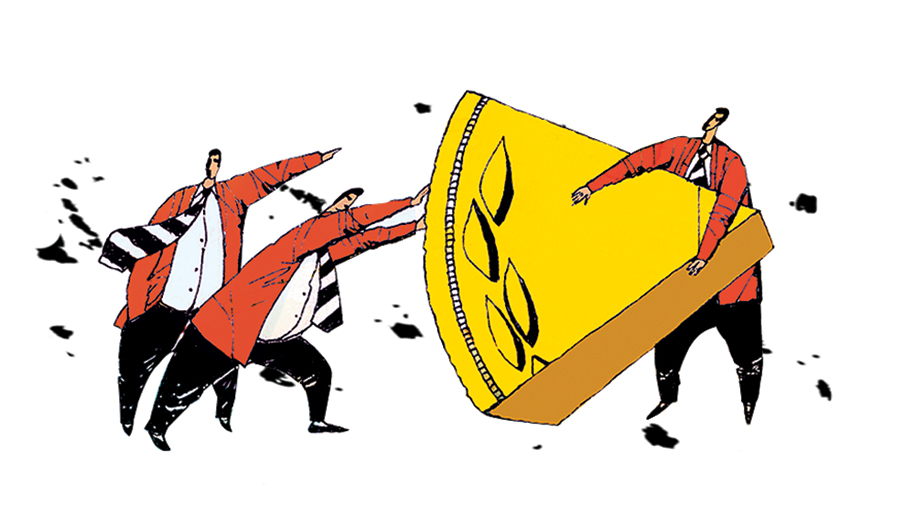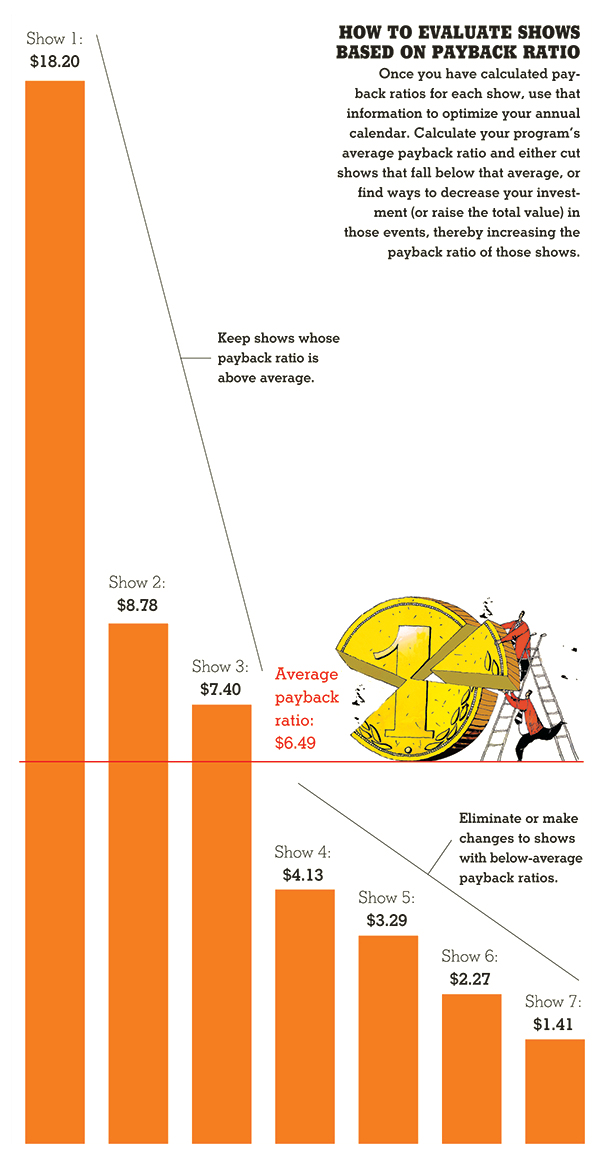Four steps to help you prove your face-to-face marketing program's worth, while identifying important metrics for establishing benchmarks and tracking incremental success. By Ed Jones
Let's face it: Most exhibitors are unable to efficiently communicate the true value of their marketing efforts. In fact, according to EXHIBITOR Magazine's 2015 Sales Lead Survey, only 35 percent of marketers track the percentage of leads sourced at trade shows that yield actual sales. And less than half of exhibitors routinely calculate the return on investment of their trade show participation.
Most exhibit managers say that they don't allocate time for tracking such metrics because management isn't asking for them. But does that mean you shouldn't be tracking (and reporting) them anyway? No. When the budgetary ax starts swinging – or stakeholders question whether trade shows are a worthwhile investment – you are going to want the data to prove your face-to-face program's worth, and you're going to want it fast.
More importantly, knowing and conveying the true value of trade show and event marketing will result in better strategies and designs, as well as more participation and support from the C suite and a broader set of team members within your company.
So to help you measure the value of exhibiting, here is a tried-and-true, four-step method. Sure, it's going to take some time to compile the necessary data, but you'll be thankful you did if the value of your program is ever called into question.
1. Identify the Estimated Impact on Your Company's Revenue
Revenue can be the most difficult measurement to track at a trade show because you don't usually close a deal on the show floor. The lead is typically routed to the sales team, and depending on the length of the sales cycle, it may take months or even years to turn into an actual sale. And by then, there may be no way to track it back to the original trade show. Of perhaps equal or greater importance is the impact of your event-marketing program on protecting and growing your organization's existing business.
But you don't have to wait to measure the revenue generated from a show. You can approximate the value using commonly accepted, internal assumptions that are based on the experience of your sales department. First, gather the following information:
➤ Number of sales leads. Identify the number of booth visitors who commit to a sales contact or other specific sales-related step after the show.
➤ Close rate. Ask your sales team to estimate the average percentage of trade show leads that ultimately result in a sale or contract.
➤ Average value of a sale or contract. Again, a sales manager should be able to provide this data. If you'll be promoting multiple product lines at the show, develop a weighted average based on the level of interest for each product in your exhibit.
Then, use the following equation to calculate estimated revenue:
X
X
=

Since this formula is based on real statistics provided by your sales department, sales managers will be more likely to accept the estimate as a true and accurate measure of your program's potential revenue impact. Then it's the sales team's responsibility to close those sales.
As for revenue protection, find out how many existing clients will be at the event in question. Determine the dollar value of any accounts that are in jeopardy, and create a plan to address them in hopes of retaining those clients.
Also, with the help of sales, estimate the number and value of up-sell and cross-sell opportunities that might be accomplished at the trade show. Then add the potential value of any viable revenue protection and up-sell or cross-sell opportunities to your estimated revenue figure for a more comprehensive, inclusive total.
2. Tally Total Savings
In addition to generating sales revenue, exhibiting can also save your company money, and every dollar of cost avoidance is tantamount to a dollar of profit. So include any savings incurred as a result of your program in calculations regarding its value.
For example, a past client of mine held 50 meetings with VIP clients in its booth at a trade show. If held independently, the client estimated those meetings would have cost an average of $1,500 each in travel and related expenses. That means exhibiting at the show saved the company $75,000.
To calculate the savings associated with your trade show participation, gather the following information:
➤ Average cost of meetings. Determine the average cost of meetings between executives, sales, channel partners, strategic alliances, technical experts, association members, investors, and industry analysts. Consider facility-rental fees as well as time, travel, and related expenses. And don't forget to include employee and supplier recruitment and purchasing activities that might also be accomplished at a show. Your accounting or sales department should be able to give you this information.
➤ Field-sales costs. A well-executed program may eliminate two or more sales calls in the field that a salesperson would have to otherwise make. In my experience, these calls cost a company anywhere from $100 to more than $3,000. Ask your accounting or sales director to estimate this cost.
➤ Name-acquisition costs. Identify the cost associated with acquiring names for the sales and marketing databases.
Trade shows provide hundreds of new, qualified contacts. If your company spends anything to rent or acquire names and email addresses or other contact information, it will be easy to put a value on these contacts. If not, consult list-rental firms to estimate the cost of contacts in your industry.
➤ Other cost savings. Calculate the value of other cost-savings activities at the trade show, such as reuse of creative materials for field-sales activity or for future corporate events.
Once you have obtained that data, plug the numbers, as applicable, into the following formula:
Total Cost Savings
+
+
+
=
Remember, the total cost-savings number is not a measure of how well you cut costs or saved money with regard to your trade show budget. It's the amount of money the company would have spent on meetings, sales calls, list-rental fees, etc. to achieve the same results you accomplished at the event or in your exhibit.
3. Factor the Value of Promotional Activities and Impressions
To calculate the quantity of impressions generated at a show, list your promotional activities that are seen or heard by an audience. Generally, you can divide these activities into four categories: 1) direct marketing, 2) media coverage, 3) on-site promotion, and 4) the exhibit. Remember, attendees who visit your booth and the people who see your exhibit from the aisle but do not step inside are considered impressions. If you are conducting any off-site events or activations, include those as well.
Next, figure out the total number of people each activity reached (those are counted as gross impressions or GIs) and what percentage of those people fit your target-audience profile (which are noted as targeted impressions or TIs). Many show organizers will be able to provide information on the number of potential impressions generated by official sponsorships, such as signage in the registration area or sponsorship of a particular event or reception. If this info isn't available, estimate using observation and logic.
Consult your public relations and advertising departments to see if they have an established method of quantifying the value of impressions. If so, apply their system to your calculations. If not, consider the cost to acquire the same exposure through advertising or direct marketing. For instance, you could determine the cost of a full-page ad in a relevant periodical, plus all creative costs, divided by that publication's circulation. That will give you a cost-per-impression figure you can use to quantify the value of GIs. Then, if possible, determine the percentage of that publication's readership that fits your target profile and run your calculation again to assign a value to the TIs.

Use the following formulas to assign a value to gross impressions (GIs) and targeted impressions (TIs) from a show.
Total Gross Impressions
+
+
+
=
X
=
+
+
+
=
Keep in mind that since TIs are also represented in the GIs figure (as GIs count all impressions, including TIs), you can only add the additional value of TIs or you are inadvertently counting those impressions twice. So when calculating the total promotional value of a show, add the value of all GIs to the additional value of TIs by multiplying the number of targeted impressions by the difference in value between a GI and a TI.
Total Promotional Value
X
=
+
=
4. Determine the Payback Ratio
Once you're done calculating estimated revenue, cost savings, and promotion/communication value for your participation at a show, add those figures together to determine the total estimated value of your presence:
Total Estimated Value
+
+
=
Then divide the total estimated value of the show by your total show budget to determine the event's payback ratio, which might be expressed as $10/1. Note that payback ratio is not the same as ROI. This ratio takes into account more than just revenue generation, making it a more holistic valuation of your exhibiting program.
Payback Ratio
÷
=
This payback ratio will help you quantify the value of each trade show and compare one event to another in an apples-to-apples manner. It may also help you answer the following questions: Does this trade show bring enough value to our organization to justify exhibiting? Should we adjust our investment in this show, such as increasing or decreasing the size of our exhibit space, bringing a smaller staff to the event, or taking advantage of more promotional opportunities? Which of our annual events generates the biggest bang for our buck?
You can also use the payback ratios from several shows to evaluate your current shows and decide how much to spend and which events to fund the following year. First, calculate the average payback ratio from all trade shows on your annual calendar. Then examine each show that falls below the average, and determine whether it is worth attending in the future.
Using this measurement strategy will yield metrics that stakeholders in your company will understand, because they helped to create them. Furthermore, the results will help you justify and improve your program, and they'll give others a new appreciation for what you are contributing to the bottom line. E

Source: Exhibitoronline.com




0 comments:
Post a Comment